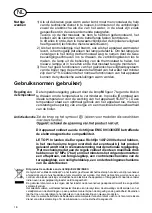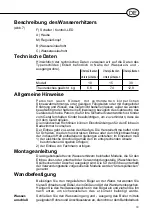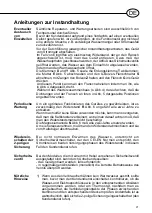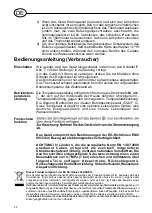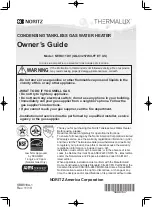
of the “T” piece union, screw a valve for draining the appliance that can
only be operated with the use of a tool (B fig. 1). On the other side of the
“T” piece union screw the safety valve (A fig. 1). This should be connect
to the cold water network via flexible pipe. Also attach in the case that the
emptying tap should be opened a waste pipe to exit C fig. 1.
A slight drip during the heating phase is quite normal; for this very reason,
we recommend you connect this drain, leaving it always open, to a drain
pipe installed inclined continuously downwards and place without
condensation. In case of pressure on the network close to the calibration-
values of the valve, it is needed to apply a pressure-reducer as far as
possibile from the boiler.
8
GB
Putting it
into service
and testing
Filling the boiler with the network water is the last thing to do, before
connecting the tension. It is carried out by opening the tap of the central
domestic system and hot-water system till all the air from the boiler is out.
Check visually for any leaks; may sure that the position of the autoclave
flange is centred; eventually tighten with moderation the nut E fig. 5, so
connect it, move the switch F from 0 position to the I position fig. 7.
For models which are not fitted with a switch, provide electrical power by
turning the control knob in a clockwise direction.
Electrical
connection
The feeding cable (type H05 V V - F 3x1.5 diameter 8.5 mm) is to be
inserted in the proper hole F fig. 3 situated in the back of the apparatus
and slide it until ir reaches the housing slot V fig. 5 near the thermostat.
To disconnet the unit from the network use a bipolar switch conform to
CEI-EN standards (contact opening at least 3 mm, better if equipped with
fuses).
The electric connection is carried out directly to the clamps M fig. 5 of the
thermostat.
The appliance must be earthed and the earth cable (which must be yellow-
green and longer than that of the phases) is fixed to the terminal T fig. 5
marked by the symbol . Before starting it working, make sure that the
network tension is in compliance with the rating values of the apparatus.
If the appliance has no power supply cable, it can be connected to
the mains with a rigid tube or a flexible cable.
“Free drain”
connection
For this type of installation it is needed to utilise suitable watertaps and
carry out the connection as shown in the scheme fig. 2. With this method,
the water heater can operate at any mains pressure. Do not connect the
tap on the outlet pipe since this acts as a blend pipe.
Maintenance instructions
All intervention ad maintenance operations must be performed by qualified
personnel only.
Before calling the Technical Assistance service in the event of a suspected
malfunction, you should first check whether this is due to other causes,
such as (for example) a temporary power failure or a water shortage.
Before starting any maintenance work, disconnect the apparatus from the
electricity network.
Before working on the heating element welded to the flange, remember
to empty the appliance. To do this, shut the main tap, open the drain of
the safety valve and turn on the water tap to empty the inlet pipe.
Disconnect the X and Y terminals and the earth one T unscrewing the nut
Incidental
replacement
of particulars
Summary of Contents for 10
Page 2: ......
Page 45: ...RU 43 Аристон Термо Груп ...
Page 49: ...UA 47 Арістон Термо Груп ...
Page 53: ...LT 51 ...
Page 57: ...LV 55 ...
Page 61: ...EE 59 ...
Page 64: ...62 KZ ...
Page 65: ...KZ 63 ...
Page 67: ...KZ 65 ...
Page 73: ...BG 71 ...
Page 76: ...74 AR ...
Page 77: ...AR 75 ...
Page 78: ...76 AR ...
Page 79: ...AR 77 ...
Page 86: ...F 3 G 4 6 4 5 ...
Page 88: ...WE MAKE USE OF RECYCLED PAPER 420010023405 0811 ...




















